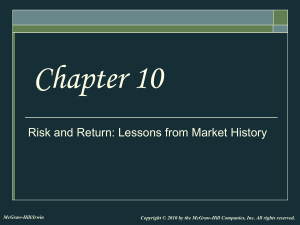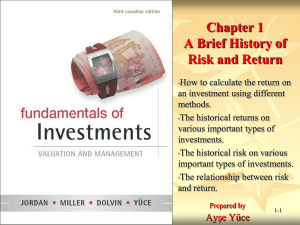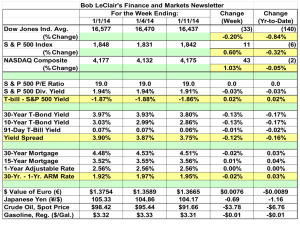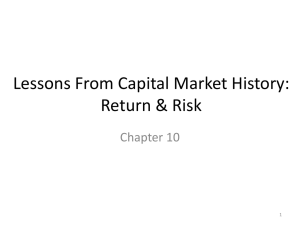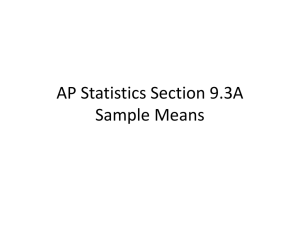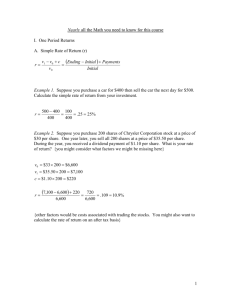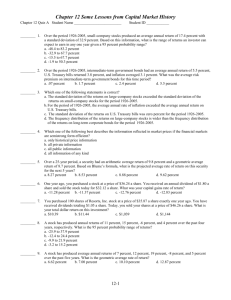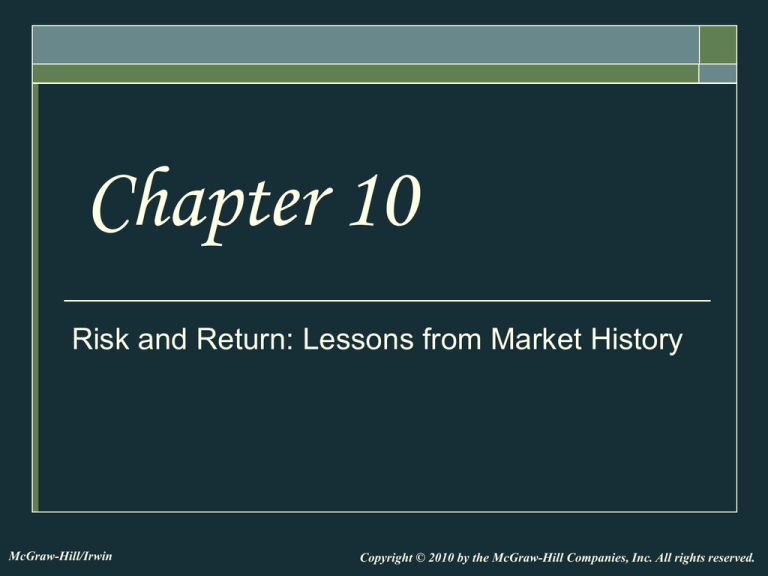
Chapter 10
Risk and Return: Lessons from Market History
McGraw-Hill/Irwin
Copyright © 2010 by the McGraw-Hill Companies, Inc. All rights reserved.
Key Concepts and Skills
Know how to calculate the return on an
investment
Know how to calculate the standard deviation of
an investment’s returns
Understand the historical returns and risks on
various types of investments
Understand the importance of the normal
distribution
Understand the difference between arithmetic and
geometric average returns
10-1
Chapter Outline
10.1
10.2
10.3
10.4
Returns
Holding-Period Returns
Return Statistics
Average Stock Returns and Risk-Free
Returns
10.5 Risk Statistics
10.6 More on Average Returns
10.7 The U.S. Equity Risk Premium: Historical
and International Perspectives
10-2
10.1
Returns
Dollar Returns
Dividends
the sum of the cash received
and the change in value of the
asset, in dollars.
Time
0
Initial
investment
Ending
market value
1
Percentage Returns
–the sum of the cash received and the
change in value of the asset, divided
by the initial investment.
10-3
Returns
Dollar Return = Dividend + Change in Market Value
dollar return
percentage return
beginning market val ue
dividend change in market val ue
beginning market val ue
dividend yield capital gains yield
10-4
Returns: Example
Suppose you bought 100 shares of Wal-Mart
(WMT) one year ago today at $45. Over the last
year, you received $27 in dividends (27 cents per
share × 100 shares). At the end of the year, the
stock sells for $48. How did you do?
You invested $45 × 100 = $4,500. At the end of
the year, you have stock worth $4,800 and cash
dividends of $27. Your dollar gain was $327 = $27
+ ($4,800 – $4,500).
$327
Your percentage gain for the year is: 7.3% =
$4,500
10-5
Returns: Example
Dollar Return:
$27
$327 gain
$300
Time
0
-$4,500
1
Percentage Return:
$327
7.3% =
$4,500
10-6
10.2 Holding Period Return
The holding period return is the return
that an investor would get when holding
an investment over a period of T years,
when the return during year i is given as
Ri:
HPR (1 R1 ) (1 R2 ) (1 RT ) 1
10-7
Holding Period Return: Example
Suppose your investment provides the
following returns over a four-year
period:
Year Return
1
10%
2
-5%
3
20%
4
15%
Your holding period return
(1 R1 ) (1 R2 ) (1 R3 ) (1 R4 ) 1
(1.10) (.95) (1.20) (1.15) 1
.4421 44.21%
10-8
Historical Returns
A famous set of studies dealing with rates of returns
on common stocks, bonds, and Treasury bills was
conducted by Roger Ibbotson and Rex Sinquefield.
They present year-by-year historical rates of return
starting in 1926 for the following five important
types of financial instruments in the United States:
Large-company Common Stocks
Small-company Common Stocks
Long-term Corporate Bonds
Long-term U.S. Government Bonds
U.S. Treasury Bills
10-9
10.3 Return Statistics
The history of capital market returns can be
summarized by describing the:
average return
( R1 RT )
R
T
the standard deviation of those returns
( R1 R) 2 ( R2 R) 2 ( RT R) 2
SD VAR
T 1
the frequency distribution of the returns
10-10
Historical Returns, 1926-2007
Series
Average
Annual Return
Standard
Deviation
Large Company Stocks
12.3%
20.0%
Small Company Stocks
17.1
32.6
Long-Term Corporate Bonds
6.2
8.4
Long-Term Government Bonds
5.8
9.2
U.S. Treasury Bills
3.8
3.1
Inflation
3.1
4.2
– 90%
Distribution
0%
+ 90%
Source: © Stocks, Bonds, Bills, and Inflation 2008 Yearbook™, Ibbotson Associates, Inc., Chicago (annually updates work by
Roger G. Ibbotson and Rex A. Sinquefield). All rights reserved.
10-11
10.4 Average Stock Returns and Risk-Free Returns
The Risk Premium is the added return (over and above
the risk-free rate) resulting from bearing risk.
One of the most significant observations of stock market
data is the long-run excess of stock return over the riskfree return.
The average excess return from large company common
stocks for the period 1926 through 2007 was:
8.5% = 12.3% – 3.8%
The average excess return from small company common
stocks for the period 1926 through 2007 was:
13.3% = 17.1% – 3.8%
The average excess return from long-term corporate bonds
for the period 1926 through 2007 was:
2.4% = 6.2% – 3.8%
10-12
Risk Premiums
Suppose that The Wall Street Journal announced that
the current rate for one-year Treasury bills is 2%.
What is the expected return on the market of smallcompany stocks?
Recall that the average excess return on small
company common stocks for the period 1926
through 2007 was 13.3%.
Given a risk-free rate of 2%, we have an expected
return on the market of small-company stocks of
15.3% = 13.3% + 2%
10-13
The Risk-Return Tradeoff
18%
Small-Company Stocks
Annual Return Average
16%
14%
Large-Company Stocks
12%
10%
8%
6%
T-Bonds
4%
T-Bills
2%
0%
5%
10%
15%
20%
25%
30%
35%
Annual Return Standard Deviation
10-14
10.5 Risk Statistics
There is no universally agreed-upon
definition of risk.
The measures of risk that we discuss are
variance and standard deviation.
The standard deviation is the standard statistical
measure of the spread of a sample, and it will be
the measure we use most of this time.
Its interpretation is facilitated by a discussion of
the normal distribution.
10-15
Normal Distribution
A large enough sample drawn from a normal
distribution looks like a bell-shaped curve.
Probability
The probability that a yearly return
will fall within 20.0 percent of the
mean of 12.3 percent will be
approximately 2/3.
– 3s
– 47.7%
– 2s
– 27.7%
– 1s
– 7.7%
0
12.3%
68.26%
+ 1s
32.3%
+ 2s
52.3%
+ 3s
72.3%
Return on
large company common
stocks
95.44%
99.74%
10-16
Normal Distribution
The 20.0% standard deviation we found
for large stock returns from 1926
through 2007 can now be interpreted in
the following way:
If stock returns are approximately normally
distributed, the probability that a yearly
return will fall within 20.0 percent of the
mean of 12.3% will be approximately 2/3.
10-17
Example – Return and Variance
Year
Actual
Return
Average
Return
Deviation from the
Mean
Squared
Deviation
1
.15
.105
.045
.002025
2
.09
.105
-.015
.000225
3
.06
.105
-.045
.002025
4
.12
.105
.015
.000225
.00
.0045
Totals
Variance = .0045 / (4-1) = .0015
Standard Deviation = .03873
10-18
10.6 More on Average Returns
Arithmetic average – return earned in an average
period over multiple periods
Geometric average – average compound return per
period over multiple periods
The geometric average will be less than the arithmetic
average unless all the returns are equal.
Which is better?
The arithmetic average is overly optimistic for long
horizons.
The geometric average is overly pessimistic for short
horizons.
10-19
Geometric Return: Example
Recall our earlier example:
Year Return
1
10%
2
-5%
3
20%
4
15%
Geometric average return
(1 Rg ) 4 (1 R1 ) (1 R2 ) (1 R3 ) (1 R4 )
Rg 4 (1.10) (.95) (1.20) (1.15) 1
.095844 9.58%
So, our investor made an average of 9.58% per year,
realizing a holding period return of 44.21%.
1.4421 (1.095844) 4
10-20
Geometric Return: Example
Note that the geometric average is not
the same as the arithmetic average:
Year Return
1
10%
2
-5%
3
20%
4
15%
R1 R2 R3 R4
Arithmetic average return
4
10% 5% 20% 15%
10%
4
10-21
Perspectives on the Equity Risk Premium
Over 1926-2007, the U.S. equity risk premium has
been quite large:
Earlier years (beginning in 1802) provide a smaller
estimate at 5.4%
Comparable data for 1900 to 2005 put the international
equity risk premium at an average of 7.1%, versus 7.4% in
the U.S.
Going forward, an estimate of 7% seems reasonable,
although somewhat higher or lower numbers could
also be considered rational
10-22
Quick Quiz
Which of the investments discussed has had
the highest average return and risk premium?
Which of the investments discussed has had
the highest standard deviation?
Why is the normal distribution informative?
What is the difference between arithmetic and
geometric averages?
10-23

